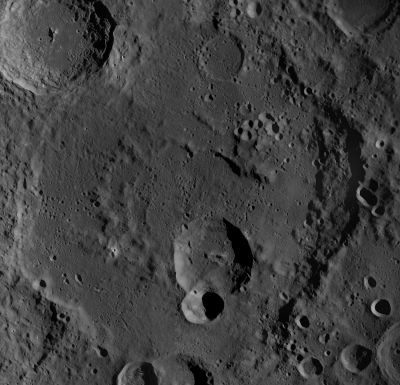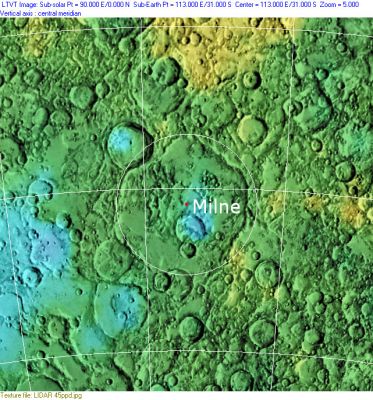Milne
Contents
[hide]Milne Basin
(unofficial name; IAU crater name: Milne; 272 km diam)
| Lat: 31.13°S, Long: 112.67°E, Main ring diam: 272 km, Basin depth: 3.25 km, Rükl: (farside) | |
Right: Clementine, Clementine LIDAR Altimeter texture from PDS Map-a-Planet remapped to north-up aerial view by LTVT. The dot is the center position and the white circle the main ring position from Chuck Wood's Impact Basin Database. Grid spacing = 10 degrees.
Images
LPOD Photo Gallery Lunar Orbiter Images Apollo Images
Maps
(LAC zone 101D4) USGS Digital Atlas PDF
Basin Classification
(description of terms and most numeric basin data from Wood, C.A. (2004) Impact Basin Database)
| Certainty of Existence |
USGS Age |
Wilhelms Age Group |
Ring Diameters |
Mare Thickness |
Mascon |
| Probable |
Pre-Nectarian |
125, 262 km |
Description
Description: Wikipedia
Additional Information
- Milne E mapped as Copernican by USGS.
- IAU page Milne
Nomenclature
The IAU crater name honors Edward Arthur Milne FRS (February 14, 1896 – September 21, 1950), a British mathematician and astrophysicist. Milne's earlier work was in mathematical astrophysics. From 1932 he also worked on the problem of the "expanding universe" and in Relativity, Gravitation, and World-Structure (1935), proposed an alternative to Albert Einstein's general relativity theory. His later work, concerned with the interior structure of stars, aroused controversy. Milne was president of the Royal Astronomical Society, 1943–1945.
- The impact basin is named after the crater.
LPOD Articles
Bibliography
Named Features -- Prev: Mills -- Next: Mineur

